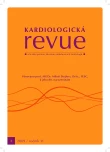Immunosuppression treatment following heart transplantation
Authors:
L. Špinarová; J. Vítovec
Authors‘ workplace:
I. interní kardioangiologická klinika, LF MU Brno
Published in:
Kardiol Rev Int Med 2009, 11(2): 63-65
Overview
In recent years, heart transplantation is the treatment of choice in patients with severe heart failure. Immunosuppressants form the basis of pharmacotherapy in these patients. The traditional immunosuppressants are cyclosporin, azathioprine and glucocorticoids. Newer treatment schedules include cyclosporin, mycophenolate mofetil and glucocorticoids or tacrolimus, mycophenolate mofetil and glucocorticoids. Recently, combinations without nephrotoxic calcineurin inhibitors (cyclosporin or tacrolimus) are preferred in post‑orthotopic heart transplantation (OHT) patients with renal function impairment. Sirolimus or everolimus are used instead in combination with mycophenolate. We aim to cease glucocorticoids in all treatment regimens after the first year of treatment with the resulting two‑drug combination being life-long. Drug interactions are the most frequently linked to cyclosporin. The drugs that increase cyclosporin levels include amiodarone, cimetidine, steroids, diltiazem, erythromycin nicardipine, oral contraception, ranitidine and verapamil. The increased cyclosporin levels might lead to nephrotoxicity. On the other hand, the drugs that decrease cyclosporin levels might cause rejection (e. g. carbamazepine, antituberculotics, cholestyramine, phenobarbital). Concomitant administration of azathioprine and allopurinol might cause bone marrow suppression. Steroids enhance the effect of cyclosporin, their combination with diuretics leads to potassium depletion and ulcerogenic effect is potentiated when combined with anti‑inflammatory agents. It is well known that both cyclosporin and tacrolimus are metabolised via the CYP 450 3A4 as are atorvastatin, lovastatin, simvastatin or the newer rosuvastatin. Consequently, an interaction between these drugs may lead to increased plasmatic concentrations of the statins and increased risk of myopathies. On the other hand, since pravastatin is not metabolised via the CYP 450 system and fluvastatin metabolises via the CYP 2C9, these agents appear to be suitable pharmacological options in the post‑OHT patients as the risk of drug interactions at the CYP 450 3A4 is minimal. In the post‑OHT patients, treatment with a low dose of any statin (atorvastatin 10 mg, lovastatin 20 mg, simvastatin 10 mg, rosuvastatin 10 mg, pravastatin 20–40 mg or fluvastatin 40 mg) should be started as soon as possible following OHT. If increased cholesterol needs further control, hydrophilic fluvastatin in retarded formulation or, alternatively, pravastatin 80 mg should be selected as they are, due to their pharmacological profile, less likely to cause myopathies. In conclusion, it is imperative that cardiologists regularly monitor their patients and consult transplantation centres if in any doubt.
Keywords:
transplantation – immunosuppression – interaction
Sources
1. Martínek V, Matoušovic K, Špatenka J. Objev a užití cyklosporinu v klinické praxi. Prakt Lék 2002; 82: 14–20.
2. Špinarová L. Transplantace srdce z pohledu kardiologa. Kardiologická revue 1999; 2: 101–105.
3. Málek I. Transplantace srdce. Postgraduální medicína 1999; 1: 95–100.
4. Krejčí J, Hude P, Špinarová L et al. Transplantace srdce – indikace, komplikace, terapie – naše zkušenosti ze sledování 100 pacientů po srdeční transplantaci. Vnitřní lék 2000; 46: 750–755.
5. Kousalová L, Baranová J, Anzenbacher P. Lékové interakce na úrovni cytochromů P450 – část 1. CYP 3A4. Klin Farmakol Farm 2003; 17: 151–157.
6. Widimský J. Poškození svalů při léčbě inhibitory HMG CoA reduktázy-statiny. Cor Vasa 2003; 45: 376–386.
7. Špinarová L, Toman J. Fluvastatin u pacientů po transplantaci srdce.Vnitř lék 1998; 44: 13–16.
8. Ballantyne CM. Statins after Cardiac Transplatation: Which Statin, What Dose, and How Low Should We Go? J Heart Lung Transplant 2000; 19: 515–517.
9. Hošková L, Málek I, Šedivý J et al. Lékové interakce cyklosporinu A. Cor Vasa 2002; 44: 481–488.
10. Lácha J. Úskalí imunosupresivní léčby. Vnitřní Lék 2003; 49: 430–433.
11. Gebauerová M, Jandová R, Málek I et al. Obraz nemocného po srdeční transplantaci. Cor Vasa 1994; 35: 258–262.
12. Rinaldi M, Pellegrini C, Martinelli L et al. FK506 effectiveness in reducing acute rejection after heart transplantation: a prospective randomised study. J Heart Lung Transplant 1997; 16: 1001–1010.
13. Špinarová L, Toman J, Hude P et al. Dlouhodobé metabolické účinky tacrolimu a cyklosporinu po transplantaci srdce. Sborník abstrakt V. konference transplantace orgánů a tkání, Brno 2002.
14. Špinarová L, Toman J. Pharmacotherapy after heart transplantation. Cor Vasa 2000; 42: 335–340.
15. Snell GI, Levvey BJ, Chin W et al. Sirolimus allows renal recovery in lung and heart transplant recipients with chronic renal impairment. J Heart Lung Transplant 2002; 21: 540–546.
16. Hunt J, Lerman M, Dewey T et al. Conversion to sirolimus lessens renal dysfunction in heart transplant patients. J Heart Lung Transplant 2004; 23: 113.
17. Viklický O, Matl I. Rapamycin: nové imunosupresivum schopné potlačit chronickou rejekci? Čas Lék Čes 2001; 140: 22–25.
18. Mancini D, Pinney S, Burkhoff D et al. Use of rapamycin slows progression of cardiac transplantation vasculopathy. Circ 2003; 108: 48–53.
19. Špinarová L, Hude P, Krejčí J et al. Vývoj imunosupresivních režimů v průběhu 10 let u pacientů po transplantaci srdce. Sborník abstrakt 6. kongresu České transplantační společnosti. Praha 14.–16. 10. 2004: 15.
20. Vítovec J, Špinar J et al. Farmakoterapie kardiovaskulárních onemocnění. 2. vyd. Praha: Grada 2004.
Labels
Paediatric cardiology Internal medicine Cardiac surgery CardiologyArticle was published in
Cardiology Review

2009 Issue 2
Most read in this issue
- Diagnosis and treatment mistakes in acute forms of ischaemic heart disease
- Immunosuppression treatment following heart transplantation
- Cardiometabolic risk is a threat for the 21st century cardiology
- Rehabilitation of patients with ischemic heart disease
